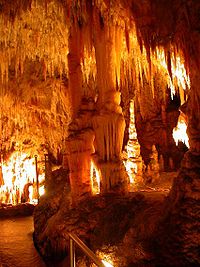
Yarrangobilly Caves
Encyclopedia

KARST
Kilometer-square Area Radio Synthesis Telescope is a Chinese telescope project to which FAST is a forerunner. KARST is a set of large spherical reflectors on karst landforms, which are bowlshaped limestone sinkholes named after the Kras region in Slovenia and Northern Italy. It will consist of...
region along the Yarrangobilly River
Yarrangobilly River
The Yarrangobilly River is a river of the state of New South Wales in Australia.It runs through Kosciuszko National Park, originating in the Fiery Range near Peppercorn Hill. From there it generally flows in a south-westerly direction through to the Talingbo Reservoir 40 kilometres away...
valley in the north of Kosciuszko National Park
Kosciuszko National Park
Kosciuszko National Park covers 690,000 hectares and contains mainland Australia's highest peak, Mount Kosciuszko for which it is named, and Cabramurra the highest town in Australia...
, New South Wales
New South Wales
New South Wales is a state of :Australia, located in the east of the country. It is bordered by Queensland, Victoria and South Australia to the north, south and west respectively. To the east, the state is bordered by the Tasman Sea, which forms part of the Pacific Ocean. New South Wales...
, Australia
Australia
Australia , officially the Commonwealth of Australia, is a country in the Southern Hemisphere comprising the mainland of the Australian continent, the island of Tasmania, and numerous smaller islands in the Indian and Pacific Oceans. It is the world's sixth-largest country by total area...
.
Discovered to British colonists by a cattleman, the Yarrangobilly Caves system includes several independent limestone caves formed over different time periods, from several million to a few hundred thousand years old. The older examples are in higher strata and have more speleothem
Speleothem
A speleothem , commonly known as a cave formation, is a secondary mineral deposit formed in a cave. Speleothems are typically formed in limestone or dolostone solutional caves.-Origin and composition:...
decoration.
The caves are administered by the National Parks and Wildlife Service. Three lit show cave
Show cave
Show caves — also called tourist caves, public caves, and in the United States, commercial caves — are caves that are managed by a government or commercial organization and made accessible to the general public, usually for an entrance fee...
s are regularly open to visitors, two for guided tours and the third for a self-guided tour
Self-guided tour
A self-guided tour is a self-governing tour where one navigates a route oneself as opposed to an escorted tour where a tour guide directs the route, times, information, and places toured...
. The caves complex also includes a 20 m long and up to 2.5 m deep 27℃ thermal pool, fed by natural warm-water spring
Hot spring
A hot spring is a spring that is produced by the emergence of geothermally heated groundwater from the Earth's crust. There are geothermal hot springs in many locations all over the crust of the earth.-Definitions:...
s, and a number of walking tracks.
History
Leo James Hoad was associated with the caves from 1904-1950, serving as the official caretaker of the caves from 1919 to 1946. He discovered the Jillabenen Cave in 1910.The largest building on the site is Caves House, built in 1901 when the caves were the most popular resort in New South Wales. It can be booked as accommodation for groups of visitors.
Show caves
South Glory Cave is a self-guided cave, with a path length of 470 metres, including 206 steps plus ramps.Jersey Cave is noted for its rare displays of black and grey flowstone
Flowstone
Flowstones are composed of sheetlike deposits of calcite formed where water flows down the walls or along the floors of a cave. They are typically found in "solution", or limestone caves, where they are the most common speleothem. However, they may form in any type of cave where water enters that...
, coloured by ash from ancient bushfires. The path length is 185 metres and includes 217 steps.
Jillabenan Cave features soda straw
Soda straw
A soda straw is a speleothem in the form of a hollow mineral tube. They grow in places where water leaches slowly through cracks in rock, such as on the roofs of caves...
stalactites, flowstone shawls, cave coral and helictite
Helictite
A helictite is a speleothem found in limestone caves that changes its axis from the vertical at one or more stages during its growth. They have a curving or angular form that looks as if they were grown in zero gravity...
s. The path length is 73 metres and includes 15 stairs. It is suitable for wheel chair access (though the Parks wheelchair must be used, as the rails over steps inside the cave are fixed-width).
The North Glory Cave has a common entrance with the South Glory through Glory Arch and features chambers such as the Queens Chamber, Helictite Chamber and Devils Kitchen. The path length is 358 metres and includes 191 stairs. It is currently closed while its lighting is upgraded.
Several other unlit caves in the Yarrangobilly complex can be visited with tours run by the NPWS: North Glory Cave and Smugglers Passage, Harrie Wood Cave and Castle Cave. These tours run daily during Christmas and Easter, or by prior arrangement, and require a minimum of eight people to run. For the unlit caves, helmets and lights are provided.
External links
- Visit NSW: About the Caves
- http://www.environment.nsw.gov.au/NationalParks/parkShowCaves.aspx?id=N0018 - NSW Dept. Environment and Climate Change

